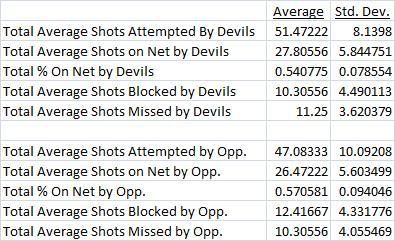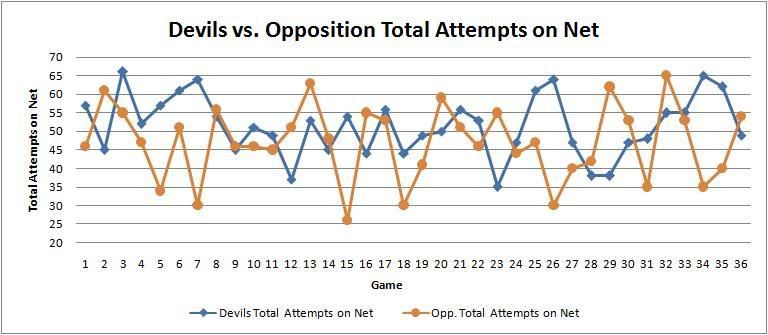Wednesday, December 26, 2007
Devils & Accuracy Part 1
With the Devils not playing until Friday against Buffalo, now is a good as time as any to be incredibly detailed with respect to stats. Last time it was penalties at the quarter-point of the season, this time it all has to do with shooting. My source for the numbers were the event summaries found with every recap of every Devils game at NHL.com.
Now, my focus for this analysis has to do with how the team is doing. The event summaries of each game are detailed enough to list how many shots each player had, how many times their shot was blocked, and how many times they missed the net. However, having gone through 36 games each for team stats, I didn't want to compile 23 additional data points times 3 (shots, blocked shots, missed shots) per game. Furthermore, there is no indication as to who blocks whose shot without delving deeper into the game report (or following it in the game itself). I could tell you, for example, that Elias had 3 shots blocked but not by who. In any case, I apologize for not taking such an analysis as deep as it could go.
Nevertheless, my focus is on how accurate the team and the opposition is in shooting the puck. Shots on net are self-explanatory. Obviously, this is what we want the Devils to have a lot of and what we want the opposition to have as few as possible. However, I don't believe it's enough to just have shots on net. The key is accuracy, so the questions that must be asked are how many times are the Devils (and the opposition) are trying to get a puck on net and how often are they successful. In addition, it is good to know how often are the Devils missing the net and how often they are getting denied. In looking at the opposition's numbers, we can get an idea as to how the defense is helping out Martin Brodeur and Kevin Weekes in terms of workload. One last thing: I'm going to be using the term "attempt on net." I have defined this to be the total of shots on net, missed shots, and blocked shots. This is assuming that a missed or blocked shot wouldn't be recorded unless it was going to be on net otherwise.
So enough explanation and background, let's get into it. What I did was I collected the total shots on net, blocked shots, and missed shots from both teams from every Devils game so far this season. In the 36 games played so far, we can safely say that the Devils are one of the better defensive teams in allowing an average of 26.47 shots per game and an average of only 47.08 attempts on net per game. This is especially favorable when you consider that the Devils average 27.81 shots on net per game and 51.47 attempts on on net per game. However, all is not rosy. The standard deviation of total attempts per game by both the Devils and their opponents is quite high, so it's a highly fluctuating value. More precisely, the opposition is much more efficient with their attempts on net, putting the biscuit on net 3% more than the Devils on average. Most importantly, the Devils are not as accurate as their opponents have been. As proof and further data, I summarized all of this into a handy chart.
My apologies for the ridiculous lack of precision in these values. However, the chart shows that the opposition is blocking approximately 2 more shots than the Devils block on average; the opposition is missing nearly one fewer shot than the Devils; and the percentage of attempts on net between the two parties is quite clear. The Devils, by these stats, are not as accurate as they could be. On some nights, the difference is pronounced; the 3-2 shootout win against Atlanta earlier this month had the Thrashers shooting with 83.3% hitting the net! The Devils weren't too bad in putting 56.25% on net; but the Thrashers were just hitting all of their shots on net. Fortunately or unfortunately for New Jersey, there doesn't seem to be an obvious trend; the total attempts on net and percentage of shots hitting the net vary between the two parties. These two graphs will show just that:
However, while it's clear the Devils could stand to miss fewer shots and be smarter about when they shoot the puck, we can't say whether or not this has any real affect on winning. Moreover, it's not clear as to whether playing at home or not has any affect. It could be that the Devils are not as aggressive in putting the puck on net on the road, but they are more accurate and efficient. It could be that the Devils win regardless (or in spite of) their shot accuracy. I have some further insight into that as well as a larger conclusion, but I'll get into that tomorrow. Today, I just wanted to establish my intentions; show that the Devils are not as accurate as their opponents; state how often the Devils and the opposition do get their shots blocked, miss their shots, and a percentage of attempted shots hit the net; and show there aren't any clear trends in either case.
Tomorrow: Part 2: These stats broken down by home vs. away, wins vs. losses, and an overall conclusion.
Nevertheless, my focus is on how accurate the team and the opposition is in shooting the puck. Shots on net are self-explanatory. Obviously, this is what we want the Devils to have a lot of and what we want the opposition to have as few as possible. However, I don't believe it's enough to just have shots on net. The key is accuracy, so the questions that must be asked are how many times are the Devils (and the opposition) are trying to get a puck on net and how often are they successful. In addition, it is good to know how often are the Devils missing the net and how often they are getting denied. In looking at the opposition's numbers, we can get an idea as to how the defense is helping out Martin Brodeur and Kevin Weekes in terms of workload. One last thing: I'm going to be using the term "attempt on net." I have defined this to be the total of shots on net, missed shots, and blocked shots. This is assuming that a missed or blocked shot wouldn't be recorded unless it was going to be on net otherwise.
So enough explanation and background, let's get into it. What I did was I collected the total shots on net, blocked shots, and missed shots from both teams from every Devils game so far this season. In the 36 games played so far, we can safely say that the Devils are one of the better defensive teams in allowing an average of 26.47 shots per game and an average of only 47.08 attempts on net per game. This is especially favorable when you consider that the Devils average 27.81 shots on net per game and 51.47 attempts on on net per game. However, all is not rosy. The standard deviation of total attempts per game by both the Devils and their opponents is quite high, so it's a highly fluctuating value. More precisely, the opposition is much more efficient with their attempts on net, putting the biscuit on net 3% more than the Devils on average. Most importantly, the Devils are not as accurate as their opponents have been. As proof and further data, I summarized all of this into a handy chart.
My apologies for the ridiculous lack of precision in these values. However, the chart shows that the opposition is blocking approximately 2 more shots than the Devils block on average; the opposition is missing nearly one fewer shot than the Devils; and the percentage of attempts on net between the two parties is quite clear. The Devils, by these stats, are not as accurate as they could be. On some nights, the difference is pronounced; the 3-2 shootout win against Atlanta earlier this month had the Thrashers shooting with 83.3% hitting the net! The Devils weren't too bad in putting 56.25% on net; but the Thrashers were just hitting all of their shots on net. Fortunately or unfortunately for New Jersey, there doesn't seem to be an obvious trend; the total attempts on net and percentage of shots hitting the net vary between the two parties. These two graphs will show just that:
However, while it's clear the Devils could stand to miss fewer shots and be smarter about when they shoot the puck, we can't say whether or not this has any real affect on winning. Moreover, it's not clear as to whether playing at home or not has any affect. It could be that the Devils are not as aggressive in putting the puck on net on the road, but they are more accurate and efficient. It could be that the Devils win regardless (or in spite of) their shot accuracy. I have some further insight into that as well as a larger conclusion, but I'll get into that tomorrow. Today, I just wanted to establish my intentions; show that the Devils are not as accurate as their opponents; state how often the Devils and the opposition do get their shots blocked, miss their shots, and a percentage of attempted shots hit the net; and show there aren't any clear trends in either case.
Tomorrow: Part 2: These stats broken down by home vs. away, wins vs. losses, and an overall conclusion.
Labels: 2008 Season, Devils Issues, Hockey - General
Comments:
<< Home
If you notice, our average accuracy went down when Pandolfo got injured. He's the most accurate we have on the team.
Exceptional report on the Devils in terms of accuracy. I hope someone from the the Devils actually see this so that they can help fix the discrepancy. Thanks for taking the time and showing it to us. :)
Off topic question for you John -- do you happen to know whatever happened to Jari Viukhola? I know he was sent to Lowell at the end of camp and played the first few games. Now I see he's stuck at 10 games played and, according to the ahl stats list, is no longer on the team. Any idea if he went back to Europe?
Steven - As I mentioned earlier in the post, the stats are broken down individually. So that's a verifiable claim. But I'm not going to look into that now, maybe in the offseason when I don't have to worry about constant stat changes.
Anon- Yes. Jari Viukhola was first sidelined with a back injury and afterwards (at least I think after the injury) he signed a contract to play with Karpat. Wikipedia's entry on Viukhola has the official story cited - in Finnish.
Post a Comment
Anon- Yes. Jari Viukhola was first sidelined with a back injury and afterwards (at least I think after the injury) he signed a contract to play with Karpat. Wikipedia's entry on Viukhola has the official story cited - in Finnish.
<< Home





